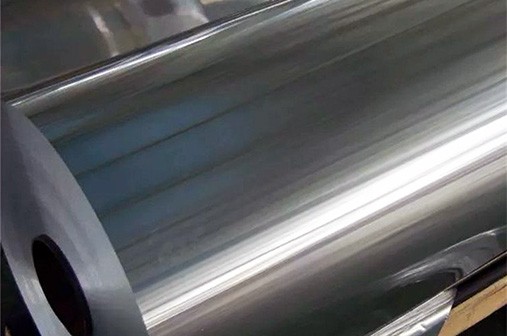- Parameters Of Color Coated Aluminum Foil
- Colored-Coated Aluminum Foil Substrate
- Colored-Coated Aluminum Foil Coatings
- Performance of Colored-Coated Aluminum Foil
- Advantages of Colored-Coated Aluminum Foil
- Color Coated Aluminum Foil Applications
- 8011 Coated Aluminum Foil for Heat Sealing Lid
- Manufacturing Process of Colored-Coated Aluminum Foil
- Common Problems Encountered when using Color-coated Aluminum Foil
Colored-coated aluminum foil is covered with a layer of paint or coating on the surface, offering both functionality and aesthetic appeal. Common types of coatings include fluorocarbon coated aluminum and polyester coated aluminum.
Colored-coated aluminum foil exhibits excellent stability, with coating colors remaining fade-resistant for many years. It possesses various functionalities such as waterproofing, steam resistance, light resistance, odor resistance, corrosion resistance, heat resistance, and cold resistance, effectively resisting changes in environment and temperature. Therefore, colored-coated aluminum foil is widely used in packaging for food, pharmaceuticals, beverages, cosmetics, and perfumes, effectively preventing moisture absorption, oxidation, volatilization, and deterioration of goods.

Parameters Of Color Coated Aluminum Foil
| Product Name | color coated aluminum foil for container |
| Alloy | 8011 3003 |
| Temper | O H12 H22 H14 H24 |
| Thickness | 40mic-150mic |
| Width | 100mm-1300mm |
| Length | as the customer’s request |
| Core | Aluminium/Steel/Paper |
| Coating lacquer | Colorless or white lacquer on one side, and plain, colorless, white, coloured lacquered or printing on the other side, lubrication is optional. |
| Coating properties | Epoxy based lacquers with excellent adhesion to aluminium foil(resistant to adhesive tape test), good solvent resistance, good friction resistance and good resistance to dry heating(2 min./240℃). Different colours available on customer request. Thickness of coating depends on color. |
| Core ID | 76mm/152mm or as request |
| Core OD | as the customer’s request; |
| MOQ | 3 tons |
| Delivery Time | around 25 days |
| Packing | Standard seaworthy export wooden cases/carton |
Colored-Coated Aluminum Foil Substrate
Colored-coated aluminum foil undergoes color treatment through coating technology. The production of aluminum foil involves pressing aluminum into extremely thin layers to meet various thickness requirements, typically ranging from 0.006 millimeters to 0.2 millimeters. Common grades of aluminum foil include 13003, 8011, 1050, each with its own characteristics:
- 3003 Colored-Coated Aluminum Foil: Contains a small amount of manganese, enhancing aluminum's strength and corrosion resistance. Widely used in fields requiring toughness and durability, such as cookware and building materials.
- 8011 Colored-Coated Aluminum Foil: Used extensively in manufacturing hydrophilic aluminum fins. These fins play a crucial role in heat exchangers, significantly improving heat transfer efficiency. The surface coating of hydrophilic aluminum fins enhances aluminum's surface hydrophilicity, aiding more effective heat transfer in radiators and cooling systems.
Through color coating, aluminum foil not only provides various colors and patterns but also enhances its durability and aesthetic appeal. This treatment typically involves applying multi-layered colored coatings, increasing the foil's decorative and functional properties. Colored-coated aluminum foil substrates are commonly used in architectural decoration, signage, packaging materials, and other fields.
Colored-Coated Aluminum Foil Coatings
Types of Coatings
Aluminum foil is coated with a layer of paint or pigment using various techniques such as roller coating, spray coating, or dip coating.
Types of Paints
Coatings may include polyester, epoxy resin, or polyurethane paints, offering durability and resistance to environmental factors.
PE Coated Aluminum Foil
- Uses: Widely applied in thermal insulation materials and protective packaging materials.
- Features: Polyethylene (PE) coated aluminum foil offers excellent thermal insulation and durability, commonly used in building insulation and packaging industries. Its surface coating effectively blocks heat transfer while providing good moisture and dust protection.
Epoxy Paint Coated Aluminum Foil
- Uses: Mainly for food containers, semi-rigid containers, and lids for food packaging production.
- Features: Epoxy paint coating provides excellent chemical stability and corrosion resistance, ensuring food safety. Its coating has high adhesion and abrasion resistance, suitable for various food packaging applications, effectively preventing food contact with the external environment.
PTFE Coated Aluminum Foil
- Uses: Used for lids of heat sealing gaskets, pipes, and conduits.
- Features: Polytetrafluoroethylene (PTFE) coated aluminum foil offers excellent heat resistance, corrosion resistance, and non-stick properties. Its coating withstands high-temperature operations, suitable for applications requiring high heat and chemical resistance, such as industrial paint booths and chemical laboratories.
Carbon Coated Aluminum Foil
- Uses: Mainly for positive electrode collectors in lithium-ion batteries.
- Features: Carbon coated aluminum foil enhances battery conductivity by applying a layer of conductive carbon material on the aluminum foil surface. It effectively increases battery charge/discharge efficiency and extends battery life. Carbon coated aluminum foil plays a crucial role in lithium-ion batteries, ensuring high performance and stability.
Color Options
Offers a variety of colors and finishes, including matte, glossy, and metallic effects.
Performance of Colored-Coated Aluminum Foil
Epoxy resin paint exhibits excellent adhesion to aluminum foil (tape test resistance), good solvent resistance, good abrasion resistance, and good dry heat resistance (2 minutes / 240°C). Different colors can be provided according to customer requirements. The coating thickness depends on the color.
Advantages of Colored-Coated Aluminum Foil
1. Aesthetic Appeal
- Multiple Colors: Offers a wide range of colors to meet design requirements for packaging, architectural facades, and decorative applications.
- Visual Impact: Enhances the appearance of products and structures, contributing to brand differentiation and visual appeal.
2. Durability
- Weather Resistance: Coatings resist UV radiation, moisture, and temperature fluctuations, suitable for indoor and outdoor use.
- Corrosion Resistance: Prevents oxidation and corrosion, prolonging the lifespan of aluminum foil.
3. Functional Advantages
- Barrier Properties: Maintains aluminum foil's ability as a barrier to light, oxygen, and moisture, crucial in packaging applications.
- Easy to Clean: Smooth coated surfaces are easier to clean and maintain compared to uncoated aluminum foil.
Color Coated Aluminum Foil Applications
3003 8011 Coated Aluminum Foil for Containers
3003 8011 color-coated aluminum foil is used to make food containers. The coating provides resistance to moisture and other environmental factors.
- Temper: H22 or H24
- Thickness: 0.03-0.20mm
- Coating: Food-grade, typically one-sided
- Application: Ideal for food packaging containers due to its formability, heat resistance, and food-safe coating.
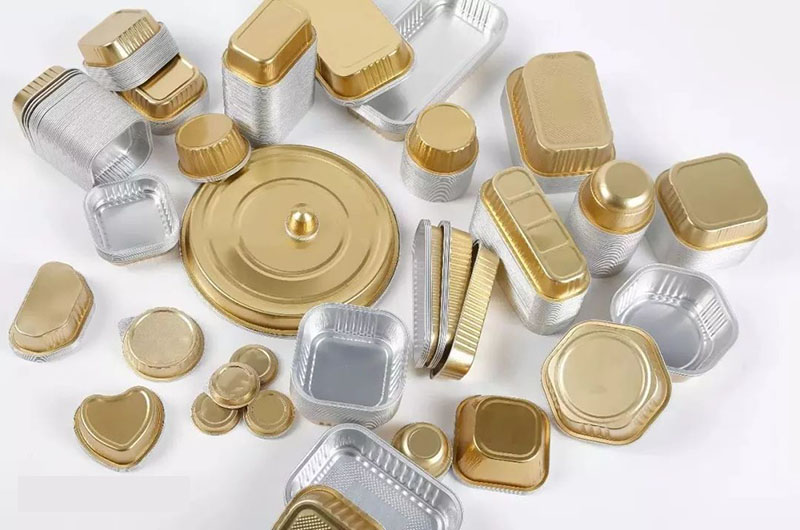
8011 Coated Aluminum Foil for Heat Sealing Lid
This product is designed to utilize heat to seal containers and the coating enhances heat sealing performance
- Temper: H14 or H16
- Thickness: 0.020-0.038mm
- Coating: Heat-sealing lacquer, usually on one side
- Application: Commonly used for sealing plastic containers in the food industry, ensuring freshness and preventing leakage.
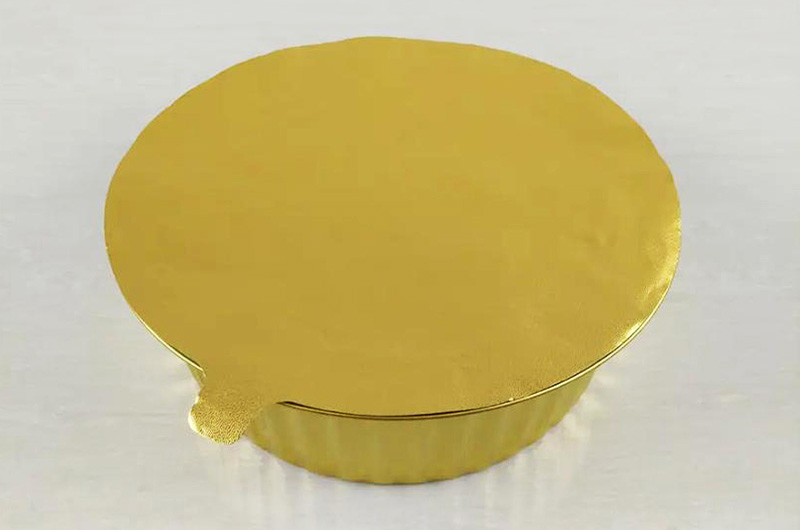
3003 Color Coated Aluminum Foil for Roofing
3003 color-coated aluminum foil is used in roofing applications and is both functional and decorative. 3003 color coating enhances durability and aesthetics.
- Temper: H24
- Thickness: 0.025-0.10mm
- Coating: PE or PVDF
- Application: Provides a durable and aesthetically pleasing roofing solution, enhancing weather resistance and UV protection.
8011 Coated Aluminum Foil for Bottle Neck
8011 color-coated aluminum foil is used to seal bottlenecks and provide a barrier to contaminants.
- Temper: H14
- Thickness: 0.020-0.050mm
- Coating: Heat-sealing lacquer, typically one-sided
- Application: Used for sealing the necks of bottles, ensuring product integrity and preventing tampering.
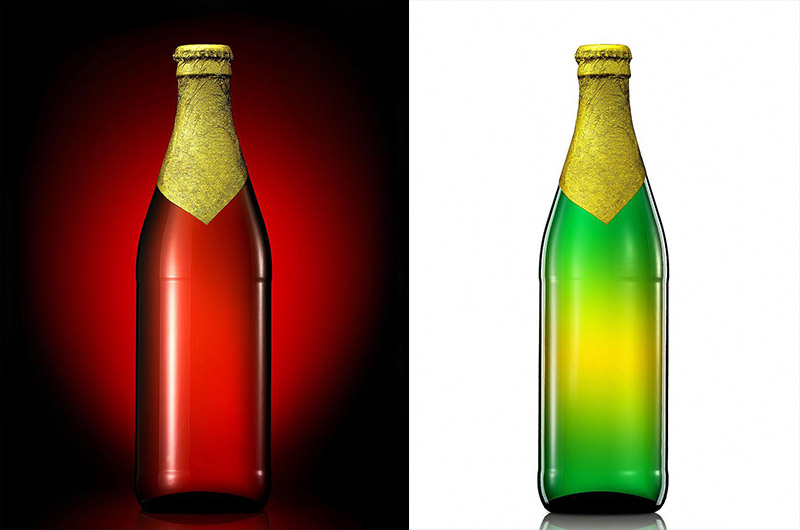
8011 Coated Aluminum Foil for Pharmaceutical Packaging
8011 color-coated aluminum foil is used for pharmaceutical packaging to form a moisture-proof, light-proof and gas-proof barrier.
- Temper: H18
- Thickness: 0.020-0.040mm
- Coating: Primer/Alu Heat Seal lacquer
- Application: Widely employed in pharmaceutical packaging to protect and preserve the integrity of medications.
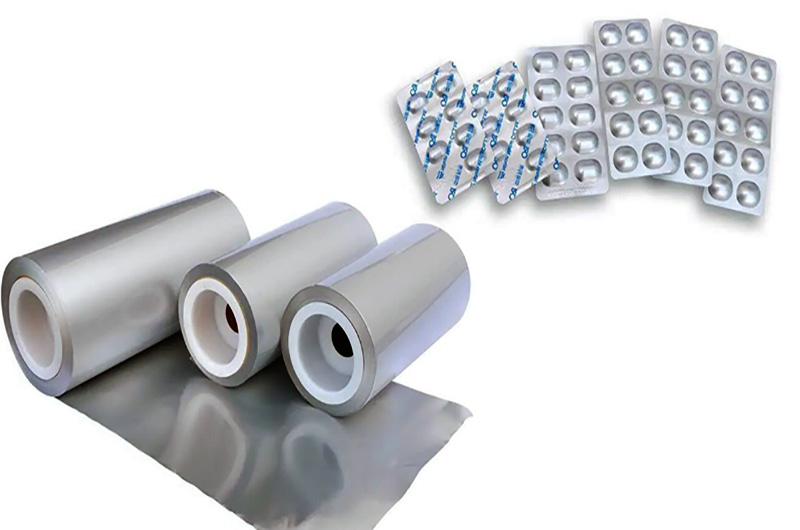
Coated Aluminum Foil for Bottle Cap
Alloy: 8011
- Temper: H16 or H18
- Thickness: 0.015-0.035mm
- Coating: Heat-sealing lacquer, typically one-sided
- Application: Commonly used for sealing and preserving beverages in bottle caps.
3003 Coated Aluminum Foil for Decoration
3003 color coated aluminum foil is used in the furniture industry for decorative purposes and is available in a variety of colors and finishes.
- Temper: H24
- Thickness: 0.018-0.10mm
- Coating: PE or PVDF
- Application: Used for decorative purposes in furniture, providing a lightweight and durable solution.
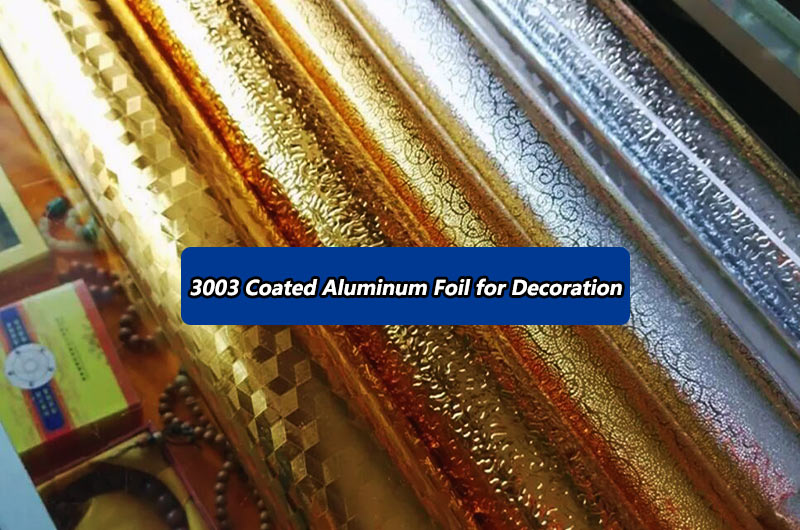
Hydrophilic Color Coated Aluminum Foil
Alloy: 1100, 1200, 3102, 8011
- Temper: H22 or H24
- Thickness: 0.08-0.2mm
- Coating: Hydrophilic coating on both sides
- Application: Mainly used in air conditioners, refrigerators, and heat exchangers for its enhanced heat exchange efficiency.
Fin Color Coated Aluminum Foil
Alloy: 1100, 1200, 3102, 8011
- Temper: H22 or H24
- Thickness: 0.08-0.2mm
- Coating: Epoxy or hydrophobic coating on one side
- Application: Applied to air conditioner fins for improved corrosion resistance and heat exchange efficiency.
Each type of coated aluminum foil has specific properties suitable for its intended application. Coatings may include materials such as polymers, varnishes, or other substances that provide desired properties, such as heat resistance, moisture resistance, or a decorative finish.
One of the key advantages of color coated aluminum foil is its high level of customization. Manufacturers can tailor the thickness, color, and finish to meet the specific requirements of their customers. This flexibility enables businesses to create unique and eye-catching packaging or design elements that align with their brand identity.
Moreover, aluminum is a highly recyclable material, contributing to the environmental sustainability of products made with color coated aluminum foil. The recycling process of aluminum requires significantly less energy compared to the production of primary aluminum, making it an eco-friendly choice for those concerned about reducing their carbon footprint.
Manufacturing Process of Colored-Coated Aluminum Foil
1. Preparation
Cleaning and Pre-treatment: Clean and pre-treat aluminum foil to ensure good coating adhesion.
2. Coating
Primer Coat: Sometimes a primer coat is applied to improve adhesion.
Color Coating: Apply color and finish of choice to the aluminum foil. This process can be continuous or batch operation, depending on production scale and requirements.
3. Curing
Heat Curing: Pass coated foils through a curing oven to fix the coating and ensure durability.
4. Quality Control
Inspection: Check final product for color uniformity, coating thickness, and other quality parameters.
Common Problems Encountered when using Color-coated Aluminum Foil
When using color-coated aluminum foil, several common problems may be encountered. Addressing these issues proactively can help improve the overall performance and satisfaction with the product. Here are some common problems:
1. Color Fading
Issue: Over time, the color on the foil may fade due to exposure to light, heat, or other environmental factors.
Solution: Store colored foil in a cool, dark place, away from direct sunlight. Choose foils with high-quality colorants that resist fading.
2. Adhesion Problems
Issue: The color coating may not adhere properly to the aluminum surface, leading to peeling or flaking.
Solution: Ensure that the foil is properly cleaned and prepared before the coating process. Use high-quality coatings and proper application techniques.
3. Scratching or Abrasion
Issue: The color coating may be prone to scratching or abrasion during handling or transportation.
Solution: Handle the foil with care, and consider using protective packaging. Opt for color-coated foils with enhanced durability or protective coatings.
4. Uneven Color Distribution
Issue: Inconsistencies in the application process may result in uneven color distribution on the foil.
Solution: Implement quality control measures during the manufacturing process to ensure even color application. Regularly inspect and maintain coating equipment.
5. Heat Resistance Issues
Issue: Some color-coated foils may not withstand high temperatures, leading to discoloration or degradation during cooking or baking.
Solution: Choose color-coated foils specifically designed for heat resistance. Clearly communicate the recommended temperature range for use.
6. Poor Print Quality (if applicable)
Issue: If the color-coated foil includes printing, poor print quality may affect the appearance and readability.
Solution: Use high-resolution printing methods, ensure proper ink adhesion, and regularly maintain printing equipment.
7. Compatibility with Food
Issue: Certain color coatings may not be suitable for direct contact with certain types of food.
Solution: Verify that the color-coated foil is food-safe and complies with relevant regulations. Consider using additional liners for specific food items if necessary.
8. Environmental Impact
Issue: Some color coatings may have environmental concerns, such as reduced recyclability.
Solution: Choose color-coated foils with environmentally friendly coatings or those that are easily recyclable. Clearly communicate disposal instructions to end-users.
9. Cost Considerations
Issue: Color-coated aluminum foil may be more expensive than plain foil, affecting overall production costs.
Solution: Evaluate the cost-benefit analysis for your specific application. Consider the added value of color-coated foil in terms of aesthetics, branding, and product differentiation.
10. Storage and Handling Precautions
Issue: Improper storage or handling may lead to dents, creases, or other physical damage to the colored foil.
Solution: Provide guidelines for proper storage and handling. Consider protective packaging or additional measures during transportation.
Regular quality control, proper handling, and selecting high-quality color-coated aluminum foil can help mitigate these common problems and ensure a positive user experience.

